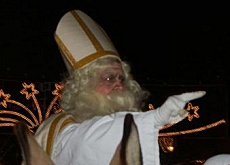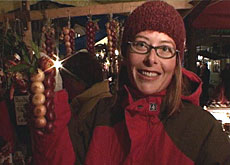Saint Nicolas comes to Fribourg town

The people of Fribourg will be in particularly high Christmas spirits on December 3, to celebrate the 100th St Nicolas parade.
The parade has been held every year without interruption since its inception in 1906.
The two days of festivities will commence on December 2 with an evening concert at the college church. Thousands of people are expected to flock into the city the next afternoon, where they will await the arrival of St Nicolas.
Riding into town on the back of a pony throwing sweets to the crowd, Fribourg’s patron saint then gives a ceremonial address from the cathedral.
This year’s Nicolas will be joined by many of the surviving men who have played the role over the decades, in order to mark the 100th time the parade has been held.
Traditionally, the pupils from the sixth year at the College of St. Michel select one of their classmates in a secret ballot to play St Nicholas.
The event will end this year with the opening of a special exhibition on the tradition at the city’s art and history museum. The show runs until January 29.
Ready, steady, ski
A few of the Swiss resorts blessed with glaciers have kicked off the ski season. The Les Diablerets glacier ski area near Gstaad has opened two kilometres of its runs.
There is skiing between 2,500m and 3,500m in the resort of Saas Fee, and on the glacier above Zermatt.
The latter two resorts are also trying to alter their reputations for being expensive. Zermatt has risen the age when children have to pay for ski passes from six to nine. Gstaad and the resorts in the Alpes Vaudoise (Villars, Leysin, Les Diablerets) are following Zermatt’s lead.
Saas Fee has taken a different approach. Parents with two or more children up to 15 years of age only have to pay for the first child.
A market for onions
The Zibelemärit, or onion market, is held on the fourth Monday of November every year.
At the break of dawn, farmers from surrounding areas converge on Bern with truckloads of onions and garlic. The decorative onion garlands are heaped high on tables and sold to the thousands of people who descend on Bern for the special occasion.
The best-known and most popular of Switzerland’s autumn markets traces its history back to the 15th century.
Legend has it that Bern granted the Fribourg farmers the right to sell their produce each November in the town as an expression of gratitude after they came to the aid of the Bernese following a great fire.
But the market is more likely to have originated in the 18th century and was associated with the “Martinmas Fair”, which was held annually in the late autumn.
swissinfo

In compliance with the JTI standards
More: SWI swissinfo.ch certified by the Journalism Trust Initiative

You can find an overview of ongoing debates with our journalists here. Please join us!
If you want to start a conversation about a topic raised in this article or want to report factual errors, email us at english@swissinfo.ch.